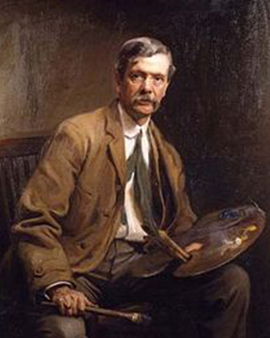Alfred East was one of the most famous landscape painters of the late Victorian and Edwardian era. East usually produced large-format works. He paid great attention to detail and almost always worked with a low perspective from which he opened the panoramic view.
Already at the age of ten Alfred East showed an early talent for drawing and received his first commission, a series of illustrations of prehistoric creatures. During his studies at the Glasgow School of Art he worked for his family's shoe company. His first publicly exhibited works were shown at the Royal Scottish Academy in the 1870s. Around 1882 he enrolled at the Académie Julian in Paris, where he studied with Tony Robert-Fleury and William Bouguereau. In 1883 he made his debut at the Royal Academy and the Royal Society of British Artists with oil paintings and watercolours influenced by the style of French naturalism. In the late 1880s and 1890s the reputation of East increased rapidly. In 1906 he was even elected president of the Royal Society of British Artists.
The critic Walter Armstrong described East as a "lyrical landscape painter" who is particularly good at capturing the atmosphere and the "mysterious side of nature": "I know of no English painter who could surpass him in rendering this delicate, barely perceptible haze, who can do for a landscape what a fine veil can do for a woman. In 1889, the 45-year-old painter had sailed to the Far East in the company of Arthur Lazenby Liberty, the owner of the famous department store on Regent Street, and Charles Holme, the later editor of The Studio. Unlike many other artist travelers, East was determined to visit rural Japan and paint the Japanese landscape, especially the area around Lake Biwa and Mount Fuji. On his return, his small oil sketches, watercolours and cabinet paintings were shown with great success at the Fine Art Society in March 1890.
The fact that after his return in the following years a discussion on the comparability of oriental and western landscape painting traditions began at the Royal Academy is largely due to Alfred East. In 1910 he was knighted by George V. and in the last years of his life he helped to build up an art gallery in his home town of Kettering. Alfred East died on 28 September 1913 in his London residence in Belsize Park. His body was brought back to Kettering and laid out in the art gallery there, surrounded by paintings that he had bequeathed to the city. Several thousand people paraded by his coffin.
×





.jpg)
.jpg)
_-_(MeisterDrucke-1102424).jpg)
_-_(MeisterDrucke-1102424).jpg)
.jpg)
.jpg)
.jpg)
.jpg)
.jpg)
.jpg)
_-_(MeisterDrucke-569373).jpg)
_-_(MeisterDrucke-569373).jpg)
_-_(MeisterDrucke-1106226).jpg)
_-_(MeisterDrucke-1106226).jpg)
.jpg)
.jpg)
.jpg)
.jpg)
.jpg)
.jpg)
.jpg)
.jpg)
.jpg)
.jpg)
.jpg)
.jpg)
.jpg)
.jpg)
_-_(MeisterDrucke-997334).jpg)
_-_(MeisterDrucke-997334).jpg)
_-_(MeisterDrucke-1122185).jpg)
_-_(MeisterDrucke-1122185).jpg)
.jpg)
.jpg)
.jpg)
.jpg)
.jpg)
.jpg)
.jpg)
.jpg)
.jpg)
.jpg)
.jpg)
.jpg)
_-_(MeisterDrucke-1113217).jpg)
_-_(MeisterDrucke-1113217).jpg)
_-_(MeisterDrucke-1209857).jpg)
_-_(MeisterDrucke-1209857).jpg)
.jpg)
.jpg)
_-_(MeisterDrucke-1103179).jpg)
_-_(MeisterDrucke-1103179).jpg)
.jpg)
.jpg)
.jpg)
.jpg)
.jpg)
.jpg)
.jpg)
.jpg)
.jpg)
.jpg)
.jpg)
.jpg)
.jpg)
.jpg)
_-_(MeisterDrucke-1122722).jpg)
_-_(MeisterDrucke-1122722).jpg)
.jpg)
.jpg)
.jpg)
.jpg)
.jpg)
.jpg)
_-_(MeisterDrucke-1113929).jpg)
_-_(MeisterDrucke-1113929).jpg)
.jpg)
.jpg)
.jpg)
.jpg)
.jpg)
.jpg)
.jpg)
.jpg)
_-_(MeisterDrucke-1117787).jpg)
_-_(MeisterDrucke-1117787).jpg)
.jpg)
.jpg)
_-_(MeisterDrucke-1103184).jpg)
_-_(MeisterDrucke-1103184).jpg)
_-_(MeisterDrucke-1508666).jpg)
_-_(MeisterDrucke-1508666).jpg)
.jpg)
.jpg)
_-_(MeisterDrucke-1106232).jpg)
_-_(MeisterDrucke-1106232).jpg)
.jpg)
.jpg)
.jpg)
.jpg)
.jpg)
.jpg)
_-_(MeisterDrucke-1103181).jpg)
_-_(MeisterDrucke-1103181).jpg)
.jpg)
.jpg)
_-_(MeisterDrucke-1102429).jpg)
_-_(MeisterDrucke-1102429).jpg)
.jpg)
.jpg)
_-_(MeisterDrucke-1129532).jpg)
_-_(MeisterDrucke-1129532).jpg)
.jpg)
.jpg)
.jpg)
.jpg)
.jpg)
.jpg)
.jpg)
.jpg)
_-_(MeisterDrucke-554539).jpg)
_-_(MeisterDrucke-554539).jpg)
.jpg)
.jpg)






